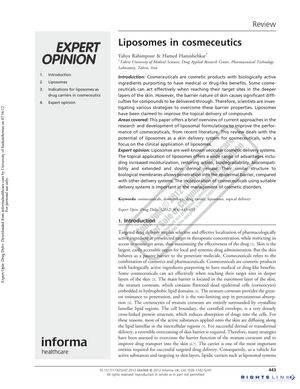Liposomes in Cosmeceuticals
March 2012
in “
Expert Opinion on Drug Delivery
”

TLDR Liposomes could improve how skin care products work but are costly and not very stable.
The document from 2012 discusses the use of liposomes in cosmeceuticals, emphasizing their potential in enhancing the delivery and efficacy of active ingredients for skin care and treatment. Liposomes are microscopic vesicles that can encapsulate both hydrophilic and lipophilic drugs, improving their delivery to the skin and reducing systemic absorption. They are suitable for topical delivery due to their biocompatibility, biodegradability, and ability to merge with cell membranes. The document highlights their advantages, such as increased drug accumulation at the skin, reduced side effects, and sustained release of active compounds, but also acknowledges disadvantages like low stability and high manufacturing costs. Studies mentioned include a 23-patient study on melasma treatment with liposomal 4-n-butylresorcinol 0.1% cream, and liposomal formulations of minoxidil and finasteride for alopecia, which may enhance drug delivery to hair follicles with reduced systemic side effects. Liposomes have also been used for UV protection, as carriers for antioxidants, and in treatments for various skin conditions such as hyperpigmentation, vitiligo, and wound healing. Despite their potential, commercialization is limited by costs and stability issues, and the document calls for more research in developing new cosmeceutical formulations.










